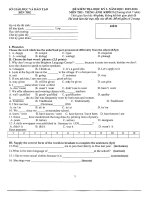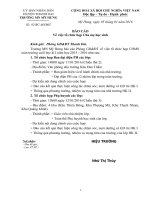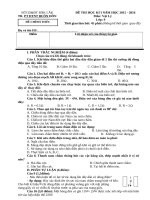- Trang chủ >>
- Khoa học xã hội >>
- Báo chí
HK I C12 20152016 BP
Bạn đang xem bản rút gọn của tài liệu. Xem và tải ngay bản đầy đủ của tài liệu tại đây (115.82 KB, 3 trang )
<span class='text_page_counter'>(1)</span>SỞ GIÁO DỤC VÀ ĐÀO TẠO BÌNH PHƯỚC ĐỀ CHÍNH THỨC. ĐỀ KIỂM TRA HỌC KỲ 1 - LỚP 12 NĂM HỌC 2015 - 2016 Môn: TIẾNG ANH Thời gian làm bài: 45 phút (không kể thời gian phát đề) (Đề gồm 3 trang, 36 câu). Họ và tên thí sinh: .......................................................................... SBD: .............................. Giám thị 1: ........................................................... Giám thị 2: ............................................... Mã đề thi: 132. SECTION A (8 points) Choose the word whose underlined part is pronounced differently from that of the other words. Question 1: A. wave B. education C. relative D. stage Question 2: A. jumped B. explained C. allowed D. arrived. Choose the word that has the main stress differently from that of the other words. Question 3: A. certificate B. education C. university D. academic Question 4: A. problem B. parent C. common D. agree Choose the best answer to complete each of the following sentences. Question 5: He is a _______ boy. He is often kind and helpful to every classmate. A. frank B. lovely C. obedient D. caring Question 6: In my family, my parents never let us ______________ up late at night. A. stayed B. stay C. staying D. to stay Question 7: David asked me ______________ English. A. that I like B. whether I liked C. if did I like D. if I like Question 8: My responsibility is to study and look ___________ my youngest sister. A. after B. down C. at D. for Question 9: Computers____________commercially for the first time in the 1950s. A. sold B. was sold C. have sold D. were sold Question 10: Maria: “I am going to take my end-of-term examination tomorrow.” Sarah: “___________!” A. Good luck B. Good time C. Good job D. Good chance Question 11: In Vietnam, three or four _____________may live in a home. A. generations B. houses C. person D. families Question 12: She is_________ about her chances of winning a gold medal. A. optimistic B. optimistically C. optimize D. optimist Question 13: In this school year, students will ______ their GCSE examination in June. A. follow B. make C. hold D. take Question 14: Tom: “You look great in this hairstyle!” Mary: “______________. I think it makes me ten years older.” A. Thanks a lot B. That’s a nice compliment C. That’s right D. You’ve got to be kidding Question 15: You won’t know what to do ___________ you listen carefully. A. in case B. unless C. if D. when Question 16: You ______________ more confident during the interview if you prepare for it well. A. felt B. will feel C. would have felt D. would feel Question 17: The job for_____________she wants to apply is well-paid. A. what B. which C. that D. whom.
<span class='text_page_counter'>(2)</span> Question 18: Did you read _____________ book that I lent you last week? A. an B. Ø C. the D. a Choose the word that is CLOSEST in meaning to the underlined word in the following sentences. Question 19: You won't last long in your job if you carry on being so rude to the customers. A. kind B. thoughtful C. impolite D. caring Question 20: When being interviewed, you should concentrate on what the interviewer is saying. A. pay all attention to B. be related to C. be interested in D. express interest to Choose the underlined part among A, B, C or D that needs correcting. Question 21: Mrs Smith, that has just come to teach at this school, has a lot of teaching experience. A B C D Question 22: Before my father retired last year, he has work for a Rubber Company for 20 years. A B C D Read the following passage carefully and fill the best answer in the gaps from 23 to 27 The reality of an interview is never as bad as your fears. For some reason people imagine the interviewer is going to jump on every tiny mistake they (23)_______. In truth, the interviewer is as keen for the meeting to go well as you are. It is what makes his or her job enjoyable. The secret of a good interview is preparing (24)________ it. What you wear is always important as it creates the first (25)_______. So dress neatly, but comfortably. Make sure that you can deal with anything you are asked. Prepare comfortably questions (26)______________ are certain to come up, for example: Why do you want to become a nurse? What is the most important quality a good nurse should have? Apart from nursing, what other careers have you (27)_______? What are your interests and hobbies? Question 23: A. have. B. perform. C. do. D. make. Question 24: A. with. B. about. C. on. D. for. Question 25: A. impressive. B. impression. C. impress. D. impressively. Question 26: A. who. B. where. C. that. D. whose. Question 27: A. consider. B. considers. C. considered. D. considering. Read the passage carefully and then choose the best answers from 28 to 32 BODY LANGUAGE AND CULTURAL DIFFERENCES The body language people use often communicates more about their feelings than the words they are saying. We use body movements, hand gestures, facial expressions, and changes in our voice to communicate with each other. Although some body language is universal, many gestures are culturally specific and may mean different things in different countries. If you want to give someone the nod in Bulgaria, you have to nod your head to say no and shake it to say yes – the exact opposite of what we do! In Belgium, pointing with your index finger or snapping your fingers at someone is very rude. In France, you shouldn’t rest your feet on tables or chairs. Speaking to someone with your hands in your pockets will only make matters worse. In the Middle East, you should never show the soles of your feet or shoes to others as it will be seen as a grave insult. When eating, only use your right hand because they use their left hands when going to the bathroom. In Bangladesh, the ‘thumbs-up’ is a rude sign. In Myanmar, people greet each other by clapping, and in India, whistling in public is considered rude. In Japan, you should not blow your nose in public, but you can burp at the end of a meal to show that you have enjoyed it. The ‘OK’ sign (thumb and index finger forming a circle) means ‘everything is good’ in the West, but in China it means nothing or zero. In Japan, it means money, and in the Middle East, it is a rude gesture..
<span class='text_page_counter'>(3)</span> Question 28: It is mentioned in the passage that many gestures __________. A. are used in greeting among men and women B. may mean different things in different countries C. are not used to communicate our feelings D. can be used to greet each other in public Question 29: People nod their head to say no in __________. A. Japan B. Bulgaria C. Belgium D. France Question 30: In the Middle East, people do not use their left hand for eating because they use their left hands _________. A. to clean their tables and chairs B. when preparing the meal C. when going to the bathroom D. to put in their pockets Question 31: Which of the following is NOT true according to the passage? A. In France, people shouldn’t rest their feet on tables. B. In Myanmar, people greet each other by clapping C. In China, the ‘OK’ sign means money D. In Belgium, snapping your fingers at someone is very rude. Question 32: The word “it” in paragraph 5 refers to __________. A. public B. nose C. Japan D. meal SECTION B (2 points) Finish each of the following sentences in such a way that it means the same as the sentence printed before it. Question 33: They believe that the robbers are acquaintances. The robbers are_________________________________________________________________ . Question 34: She revised the lessons carefully, so she did the first term exam well. If ____________________________________________________________________________ . Question 35: “Congratulations! You have passed the exam, Mary” said the teacher The teacher congratulated _________________________________________________________ . Question 36: Mr. Nam started working as a teacher two years ago. Mr. Nam has ___________________________________________________________________ . == THE END ==.
<span class='text_page_counter'>(4)</span>









